Rouen, France, June 19th - 26th, 1910
Lots of flying at the first aviation meeting in Normandy
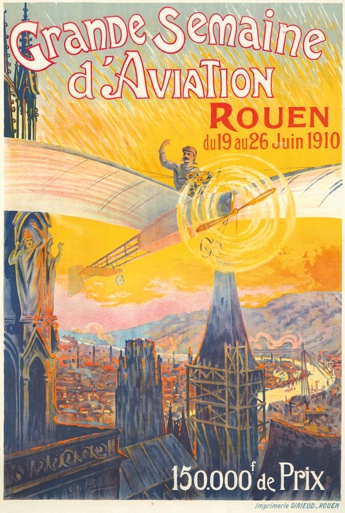
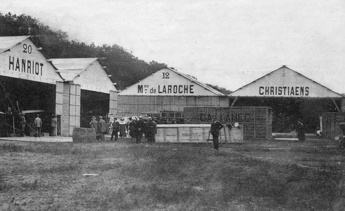



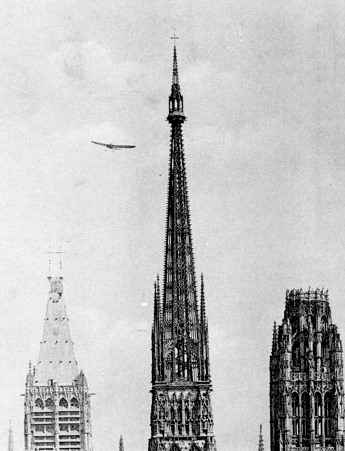

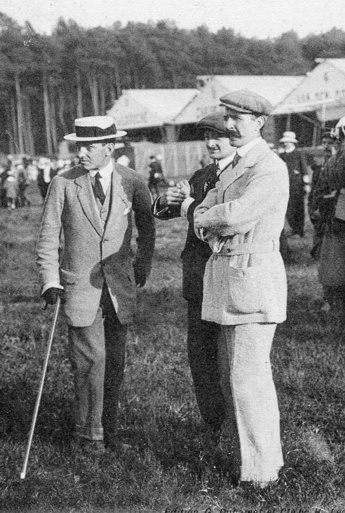
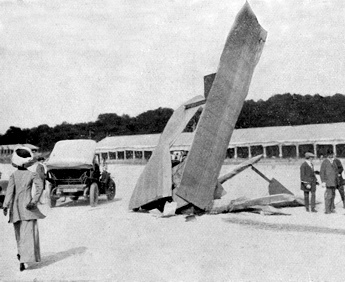
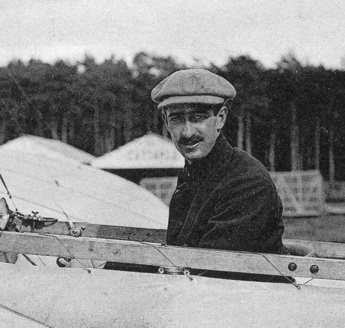
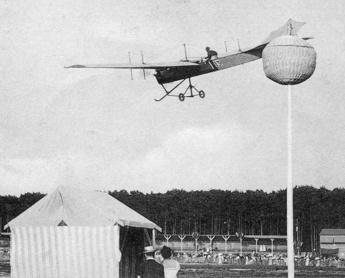



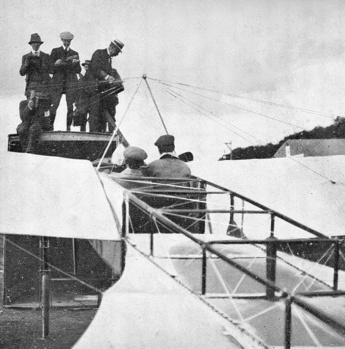
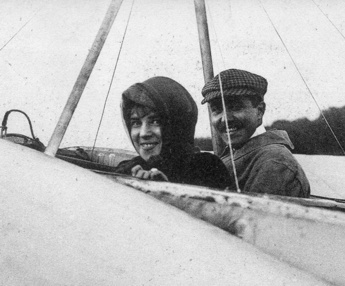

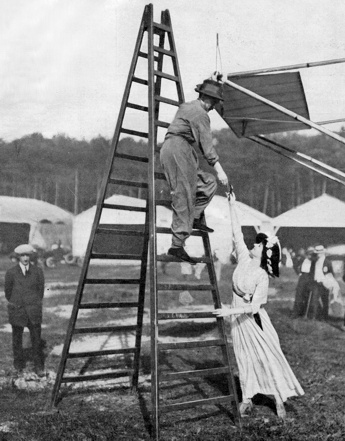


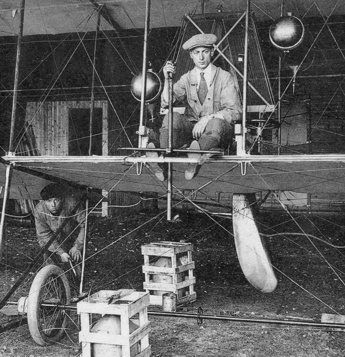
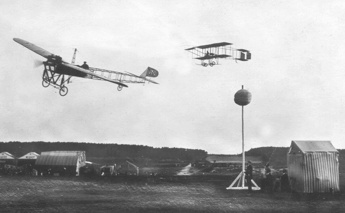
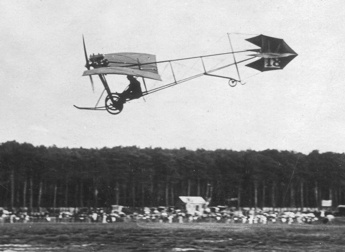
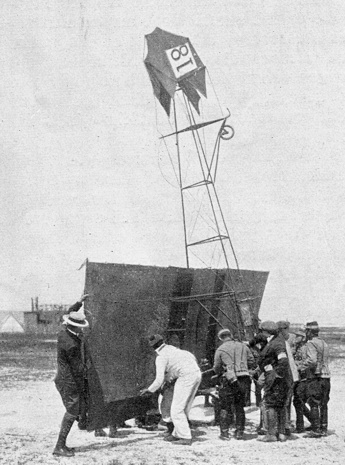

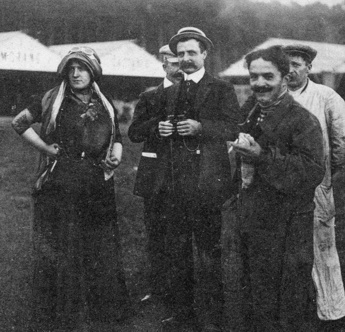

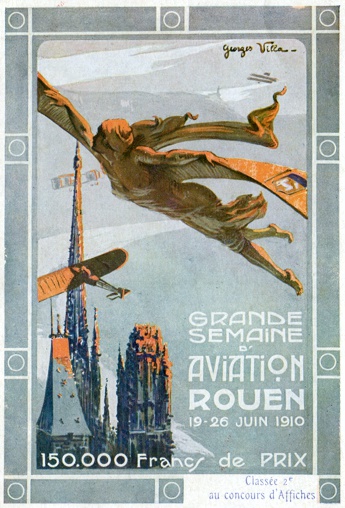
Rouen is the capital of the department of
Seine-Maritime (in 1910 called Seine-Inferieure) and the
region of Normandy in northern France. It was a town
already in Roman times and it is famous as the town where
Joan of Arc was burned in 1431. In 1910 it had a
population of around 120,000 and its harbour on the river
Seine was the seventh biggest of France, even though it
was situated 135 km upstream from the coast. It was also
an industrial town, with important textile factories.
When the French Aéro-Club published its list of
sanctioned meetings in early 1910 one of major ones was
the one in Rouen in mid-June, with an announced prize
fund of 200,000 francs. The meeting was organized by the
Automobile-Club de Normandie, supported by the Ligue
Nationale Aérienne and the sports daily
"L'Auto". The organization committee was
headed by Marcel Debons, president of the Automobile-Club
de Normandie, and comprised many members of the
Automobile-Club and representatives from local industries
and businesses. A suitable site was found, in the form of
the military exercise grounds "Les Bruyères",
six kilometres southwest of the city centre, where a
typical 1910 temporary airfield with all its
installations and a three-kilometre course was built.
The meeting attracted a quality field of twenty pilots,
all except four having participated in previous meetings.
It was reported that a total of 50,000 francs had been
paid as guaranteed appearance money. The biggest name was
the famous Hubert Latham, but several others, like Joseph
Christiaens, Charles van den Born, "Géo"
Chávez, Bertram Dickson and Léon Morane had won big
prizes at previous meetings, and Émile Dubonnet had
recently made a highly publicized flight across Paris,
winning the "La Nature" cross-country flight
prize. Several new airplane types would for the first
time be displayed at a meeting in France, for example the
Hanriot monoplane. The new Breguet biplane would also be
on display, as would the new two-seat Gnôme-engined
Blériot, model XI-2 bis.
When arriving at the airfield before the meeting the
reporters were surprised with quality of the
preparations: Grandstands, hangars, shops, flower pots,
everything was ready already before the meeting started -
the organizers had even taken the trouble to make sure
that the roads were salted in order to lay the dust. All
participants were in place before the meeting, except
Chávez, who would only arrive on the evening of the first
day. The meeting was preceded by two practice days, both
hot and sunny. On the first, Friday 17th, around 3,000
people watched young Marcel Hanriot make the first flight
on the airfield. He was only sixteen years old and had
only sat in an airplane for the first time exactly one
month before. Despite an engine that didn't seem to
run on all four cylinders he took off and flew a lap. He
was followed by Christiaens, who tested the machine of
Émile Bruneau de Laborie, and by Léon Bathiat in the
Breguet. Meanwhile the mechanics were busy with
Hanriot's engine, and at nine o'clock in the
evening he could finally make another test flight, in
front of 300-400 patient spectators.
On the afternoon of the second practice day, Saturday
18th, the organizers decided to let the curious crowds
standing in the roads outside the gates enter for the
price of one franc, which immediately filled the
grandstands with 1,500 people. Dickson was the first to
take off, at half past four, first for a short test hop
and then two laps with one of his friends as passenger.
Bathiat was next, also making a first short test,
followed by a passenger flight. This was dramatically cut
short when the wide coat of the passenger, an American,
somehow got sucked into the air-cooled engine. Bathiat
managed to make a safe landing, and the poor man jumped
off, his coat torn and slightly burned. Bathiat was more
careful to check the clothing of his next passenger, the
wife of the director of an insurance company... When they
had landed, as darkness approached, Morane, Bartolomeo
Cattaneo, Edmond Audemars and Hanriot took off, making it
four machines in the air at the same time. Morane then
took his brother on board for a trip around the
neighbouring villages. The visitors had been given good
value for their one franc!
Sunday 19 June
The first official day of the meeting was also sunny and
very hot. René Métrot was at the airfield already at five
o'clock in the morning to start his tests, despite
the morning haze. Charles van den Born also made a test
flight during the late morning. The official flights
started at eleven o'clock and van den Born took off
already two minutes past. He was followed almost
immediately by Hanriot, Dickson and Bruneau de Laborie
and ten minutes past there were already four planes in
the air. They were in turn followed by Audemars,
Cattaneo, Bathiat and Christiaens. At noon the organizers
offered a lunch for the press, and while they were eating
van den Born crashed. He had flown several laps at high
speed when the machine suddenly tumbled to the ground. He
was at a loss as to what had happened and speculated that
a rigging wire had come loose and got caught in the
propeller. Van den Born wasn't injured, but the
machine was destroyed and since he had no spare he was
out of action for the rest of the meeting.
Perhaps it was the influence of the lunch, or perhaps it
was simply the very high number of flights, but it
appears that none of the reporters managed to keep track
of all the flights during the afternoon… In total, eleven
pilots made official flights and it was reported that at
one time there were eight planes in the air at the same
time. When the laps were added up, Cattaneo had beat
Dickson to the daily distance prize by a single lap,
after flying no less than 243 kilometres. This was
despite an incident when he was sprayed in the face by
castor oil leaking from the engine and had to land to
rinse his mouth. On the other hand Dickson had made the
longest nonstop flight, staying in the air for 2 hours
27:44 and covering 141 kilometres. This beat
Cattaneo's 80 kilometres by a handsome margin and
would stand as the longest flight of the meeting.
It was also the first day of the contest for the longest
"vol plané", and Bathiat scored a gliding
flight of 426 metres, beating Dickson's 204 metres.
Both these results would also remain unbeaten during the
meeting. Cattaneo made the fastest lap, 2:18.6 over the
three kilometres, in his speedy Gnôme-engined Blériot.
Morane took the lead in the passenger contest by being
the first to fly the required 18 kilometres.
The organizers had encouraged the pilots to give the
Rouennais a surprise by making a flight over the town of
Rouen and round its famous cathedral. Van den Born and
Latham declared that they were willing to accept the
challenge, but van den Born had already crashed and
Latham had engine problems, so Morane was first to try.
He took off at 18:50 and aimed his machine towards the
city centre. He gradually reached an altitude of 150-200
metres and crossed the Seine at the northwest end of Île
Lacroix before turning left towards the cathedral. He
made a neat turn around its highest tower and then
continued westward. He crossed the Seine again at the
harbour area and returned to the airfield, without any
drama. The flight of course caused a sensation in the
town, with people cheering and waving everywhere, and
after the landing Morane was congratulated by Louis
Blériot, who visited the meeting together with his wife.
Morane was awarded a special prize of 5,000 francs for
the feat.
Among the pilots who didn't trouble the timekeepers
on the first day were Latham and Dubonnet, who only made
short tests. "Baronesse" de Laroche reached a
height of 80 metres and made a short trip outside the
airfield. Marcel Paillette obviously also had some
problems, since he made a couple of tests but
couldn't gain any height. At seven o'clock Robert
Mignot made his first flight, but he unfortunately
managed to hit a pylon and his Sommer crashed to the
ground. Again there were no injuries, but the damages
would keep him out of action for three days.
The first day of the meeting was a complete success and
the reporters compared it with the best days of the Reims
meeting of the year before. It had attracted around
100,000 visitors, and nobody could have left
disappointed.
Monday 20 June
The weather was still sunny and very hot, and the hangar
area was full of activity already in the early morning.
De Laroche was in the air already at a quarter past five
in the morning, soon followed by Dubonnet. The both flew
a single test lap. Then the wind started rising, and
reached 15 m/s by lunchtime. Despite the high winds,
Audemars went up for a flight around noon. The turbulence
made him touch the ground and during the resulting
ground-loop a wheel was broken and the machine ended up
on its nose. Spectators rushed to help the pilot, who was
entangled in the wreckage, but he was unhurt and his
machine was hardly damaged at all.
After this accident the airfield was quiet for a couple
of hours, except for the music from the band of the 74th
infantry regiment. It got slightly calmer during the
afternoon, and the first to try was Latham, famous for
his daring flight in the storm at Blackpool the year
before, and Dubonnet. They each flew a lap around four
o'clock, both obviously troubled by the turbulence
caused by the forests that surrounded the airfield, but
Latham made two further short flights during the next
couple of hours. At 18:20 Dickson tried to start, but the
mechanic holding the tail of the plane failed to release
it in time. He was thrown to the ground and fell on his
face, necessitating a visit to the airfield doctor.
By now it was rather calm, and one by one the flyers made
their machines ready. Dubonnet, Morane, Bruneau de
Laborie, Hanriot and Léon Verstraeten took off, followed
by Jean Dufour and de Laroche. In the end, when flights
stopped at half past seven, twelve of the pilots had
scored laps. Dickson had flown 66 kilometres, which beat
Cattaneo by twelve. Cattaneo still held the lead on the
total time contest, which indicates that six of
Dickson's laps the day before must have been
disallowed. According to the official program this should
have been the first day to compete for the altitude
prize, but it had obviously been rescheduled to the
Wednesday.
The organizers announced that in view of the weather and
light conditions they had changed the schedule for the
official flights, postponing them to open at two
o'clock and close at eight.
Tuesday 21 June
The weather on the third day of the meeting was grey, and
a wind of 10-15 m/s blew from the northwest. This
didn't stop the flyers, and several of them made
tests already during the morning. One of them was Latham,
who seemed to have solved his engine problems. He was
also the first to fly when the official flights started,
followed by Bruneau de Laborie, Audemars, Dubonnet,
Cattaneo and Dickson, and later by Paillette and
Bathiat.
At 15:35 Bathiat, who had flown for around ten minutes
testing a new propeller, suddenly crashed. He was caught
by the turbulent air at an altitude of around 40 metres
and pitched 45 degrees down, almost at full speed. People
in the crowd screamed as they witnessed the inevitable
disaster, while Bathiat in vain pulled his control wheel
with full force. The plane hit hard, raising a big cloud
of dust. Ten or twenty people ran to the accident site,
fearing the worst. They found Bathiat crouched on his
knees, five metres from the wreck. At first he didn't
move, but then he waved his right hand to show that he
was all right. Blood was running over his cheek, but with
the help of a gendarme and a meeting official he got onto
his feet and walked towards the grandstands. He visited
the airfield doctor, M. Fortin, and it was confirmed that
his only injuries were a bruised, sprained and grazed
left leg and a bruised and cut chin. Louis Breguet, who
had watched the accident from the hangar and driven to
the accident site at full speed to look after his pilot,
declared that since they had no spare machine the meeting
was over for them. He returned to Paris in the
evening.
Flying continued despite the accident. The next drama
occurred when Dickson's machine suddenly disappeared
from sight in a shallow valley. Rumours flew that he too
had crashed, but when the officials that drove out to his
rescue found him it turned out that he had landed under
full control after running out of fuel. Dickson and
Cattaneo both tried to get ahead in the total distance
contest and Cattaneo had to be flagged down at six
o'clock, when the first of the two qualification
trials for the speed contest, the "Prix de la
Vitesse", was due to start. The three fastest flyers
from each qualification session would participate in the
final, which would take place on the second last day of
the meeting. Cattaneo covered the three laps in 7:17,
beating Dubonnet and Christiaens by almost fifty
seconds.
Mechanics had been working on Hanriot's machine all
day, but at seven o'clock, when the speed trials were
finished, he took off and climbed high, to an estimated
300 metres. Chávez and Latham took off in pursuit,
followed by Michel Efimoff, Bruneau de Laborie, Dubonnet,
Christiaens, de Laroche, Audemars, Morane, Dickson,
Cattaneo and Verstraeten. The thirteen flyers circled the
airfield for around 45 minutes, sometimes as many as
eight in the air at the same time, "a fairy-tale
experience" according to the reporter from the
"Journal de Rouen". At 19:15 Morane was making
a flight with two passengers on board, flying low when
Latham passed close above. They got caught in the
turbulence behind Latham's machine and the heavily
loaded Blériot was forced to the ground. Morane managed
to make a controlled landing, but after the landing he
couldn't steer the plane, which swerved towards the
three-franc grandstands. The fence in front of the
grandstands fortunately stopped the machine and the only
damage was a broken propeller. One by one the other
machines landed and returned to the hangars.
Dickson had flown 174 kilometres, beating Latham and
Cattaneo and taking over the lead in the total distance
contest. The first of the three trials for the altitude
contest was originally scheduled for this day, but it was
for some reason it rescheduled to the next day.
Wednesday 22 June
The weather was still hot, but windy and very unsettled
and it rained during the morning. All through the day
dark clouds crossed the sky and it seemed that a
thunderstorm could break out at any time. Very heavy rain
fell over the Paris area and other parts of the Seine
valley during the whole day, but Rouen was lucky for a
long time.
Despite the winds there was no lack of action. Hanriot
was first to fly when official flights started at two
o'clock. He was followed minutes later by Dubonnet,
who landed after three laps. Chávez made a failed start
at 14:24, and as he returned to the hangar Verstraeten
took off. Latham also joined, covering 51 kilometres in
two flights. As usual the Dickson and Cattaneo, two major
contestants for the total distance prize, were also early
to take to the air. Both first made a test lap then
landed and took off again. Dickson circled at 40 metres,
while Cattaneo, who had the fastest machine and was
regularly forced to overtake other planes, flew higher.
Dickson landed after 54 kilometres and almost immediately
took off again. Meanwhile Paillette , Christiaens and
Dubonnet made short flights, while Hanriot landed after
42 kilometres. Soon after half past two Paillette took
off again for a flight of 66 kilometres. After flying 24
kilometres Morane left the airfield at the west side and
climbed to some 200 metres over the pines of the Forêt
des Essarts before returning to the airfield with a
spectacular dive.
The wind and the turbulence set up by the forests
resulted in several rough landings. Paillette was one of
the victims and broke the landing gear of his Sommer
after his long flight. Only ten minutes later de Laroche
was caught by the turbulence and driven towards the
five-franc grandstands. It looked like she was going to
crash into the crowds in front of the grandstands, but
she managed to avoid a disaster by steering the machine
away from them and crashed in the neutral zone between
the course and the public areas. When the baroness had
been helped from the wreckage she calmly brought out a
silver powder compact to restore her makeup before being
driven back to the hangar area, where she ordered a
citronnade from the buffet. One of the wings of her
Voisin was broken and it was reported that the machine
could easily be repaired, but she did in fact take the
train back to Paris the day after and didn't
return.
Around four o'clock it started to rain lightly and
the activity on the airfield decreased. At four
o'clock only Cattaneo was in the air. He kept flying
until 16:23, when he had reached a total of 117
kilometres. He too finished his flight with a
crowd-pleasing dive. Hanriot and Dickson made short
flights in the rain, the latter reaching a total of 105
kilometres for the day, but Verstraeten took off at 16:25
and kept flying for more than an hour, low and steady and
not very spectacular, but adding kilometre after
kilometre.
The altitude contest was scheduled to start at seven
o'clock, but it coincided with final arrival of the
expected big thunderstorm. Morane was the only one who
had time to make an effort, reaching 290 metres before
landing with a spectacular "vol plane". He also
had time to make a three-lap passenger flight before the
heavy rain stopped further action. Latham had also
intended to go for the altitude prize, but again had
engine troubles. The heavy rain lasted for an hour and
turned the airfield to a sea of mud. The grandstands,
which had been half-empty during the day, because it was
simply too hot, were invaded by people seeking cover.
Altogether, 12 pilots made official flights during the
day. Despite the rain, the total distance flown was 741
kilometres, the second highest daily score of the
meeting. Verstraeten's total of 141 kilometres won
him the daily distance prize. Dickson still led the total
distance contest by 30 kilometres. Bruneau de Laborie was
grounded with a propeller that was broken the day before,
but it was reported that it should be replaced until the
next day.
Thursday 23 June
The fifth day of the meeting had been declared a holiday
by many of the businesses of Rouen, enabling their
employees to watch the flying. Unfortunately the bad
weather from the day before continued well into the
afternoon, and the organizers were starting to worry
about the economic consequences. It kept raining until
one o'clock, with a particularly bad shower around
two o'clock, and the winds were still strong until
around four o'clock. This didn't discourage
Latham, as so often the first to brave the winds. He took
off at 15:15, when the winds were down to 7-10 m/s, and
was followed five minutes later by Hanriot. After only
four and three laps, respectively, increasing winds and a
rain shower forced them to land and retreat to their
hangars.
At 16:05, when the weather improved again,
"Gijs" Küller rolled out his ENV-engined
Antoinette for the first time. He had to land after only
three laps because of engine problems, but he was soon
followed by the other monoplane flyers, who obviously had
less respect for the winds than the biplane pilots.
Latham, Hanriot, Dubonnet, Audemars and Morane made it
six monoplanes in the air at the same time before
Küller's landing. Verstraeten, no doubt encouraged by
his good result the day before, was first of the biplane
flyers, followed by Christiaens and Efimoff.
At six o'clock it was time for the second trials for
the altitude contest. Morane was first to try, while the
indefatigable Cattaneo and Dickson took off to go for the
total distance prize. After 20 minutes and two wide
circles Morane had reached 434 metres, as usual cutting
the ignition to glide down in a steep "vol
plané" before landing. After his flight he was
carried in triumph by his enthusiastic fans. Immediately
after Morane's landing Chávez took off. He was
considered a high altitude expert and having arrived late
he hadn't achieved much during the first days of the
week. Morane, who didn't want to be beaten, took off
again and this time reached 521 metres. Chávez, taking a
bit more time to climb, soon thereafter reached 497
metres. Third in the contest was Efimoff, who reached 444
metres. Latham's engine had once again let him down
at the start of the altitude contest. The altitude
contest was as always a crowd favourite, and the flyers
were met by great ovations after their landings. Morane
was brought to the prefect of Normandie and offered a
glass of champagne. The day was finished by a nine-lap
passenger flight by Dickson.
The longest total distance of the day was achieved by
Hanriot, who flew 135 kilometres, beating Dubonnet's
123. Cattaneo reached 105 kilometres and retook the lead
in the total distance contest from Dickson, who only
managed 57. The holiday visitors had been forced to wait
for the flights, but in the end they got to see quite a
lot of good, safe flying and couldn't have been too
disappointed.
Friday 24 June
Once again the weather was bad during the morning. A
strong breeze with wind speeds reaching 13 m/s made
flights impossible. There was no action on the airfield
until noon. The first one to bring out a machine was
Mignot, who rolled out his Sommer, which was now repaired
after his accident on the first day of the meeting. The
test flight didn't go well, though. After a good
take-off the machine was caught by a gust already before
the first turn and again crashed to the ground. Mignot
was again not injured, but this time the damage would not
be repairable during the meeting. Since Mignot was the
only other pilot from Normandy it meant that Paillette
would have no competition for the "Grand Prix de
Normandie", awarded for the longest total distance
flown by a Normand.
The organizing committee offered a lunch for the flyers,
during which the president of the organizing committee,
Marcel Debons, congratulated them on their skills.
Latham, representing the pilots, returned the honours by
thanking for the thorough preparations and stating that
flyers had never been so well received.
When official flights started Latham, as usual in windy
conditions, was first. He took off at 14:10, aiming his
machine to the north, into the wind, at an angle to the
course. He flew a lap, but the winds were still strong
and he decided to land. At the same time it started
raining, and it didn't stop until three o'clock.
When conditions had improved somewhat, soon after four
o'clock, Latham was again first in the air. The wind
was still so strong that the machine hardly made any
headway at all against it, particularly at the north end
of the airfield, but downwind it went well above 100
km/h. Küller also took off soon after, flying three laps
in the same difficult conditions, before being forced to
land downwind on the back straight after an engine
failure. The flights of the two Antoinette pilots were
highly praised in the press and in the view of several
writers confirmed the superiority of the monoplanes.
Nobody else dared to fly until the winds calmed down,
around half past five, when Audemars took off in his
"golden hornet". He was followed by Efimoff,
Morane and Latham. At seven o'clock Morane took off
for a flight with two passengers. It almost ended badly
immediately, when the plane was blown to the ground and
threatened to nose over, but Morane managed to save it
and landed on the field inside the course. While this
went on Hanriot took off, and soon after Efimoff also
tried to take off with two passengers, but just like
Morane he realized that the plane was overloaded for the
conditions and he had to abort the flight immediately
after the take-off. Bruneau de Laborie made a short hop
to test his new propeller, but he was obviously not
pleased and landed already after a couple of a hundred
metres. Dickson made a flight, but landed after one lap
and returned to the hangars. It was still too windy for
the biplanes with their lighter wing loads. Then another
rain shower made the spectators run for the shelter of
the grandstands.
At around half past seven the sun shone again, and since
there was still some time before the curfew several
flyers immediately took the chance. Hanriot and Dubonnet
took off side by side at the same time, giving the
spectators "a foretaste of what racing between
aeroplanes will be in a time perhaps not so far
away", according to the reporter from
"L'Auto". Audemars and Latham also took
off, soon followed by Efimoff, who once again took two
passengers on board. During the next quarter of an hour
five flyers took the second chance to qualify for the
"Prix de la Vitesse", with Audemars coming out
on top with a time of 7:03.8, beating Latham, Hanriot and
Dickson. Küller's 7:10.6 would easily have been good
enough for second, but for some reason the time was
disallowed.
This flurry of activity only lasted for around a quarter
of an hour, before another rain shower put an end to
proceedings, some minutes before the eight o'clock
time limit. The total distance flown during the day was
213 kilometres, the shortest of the meeting. Latham's
51 km was highest total of the day, and since Cattaneo
didn't fly Dickson reduced his lead to two laps. In
the evening the Ligue Nationale Aérienne offered a
seven-course dinner at the airfield restaurant, with fine
wines from Bordeaux and Champagne and many speeches.
Saturday 25 June
The crowds visiting the airfield were once again greeted
by a heavy rain shower during the morning. Around eleven
o'clock the sun broke through the clouds, but around
noon it started raining again. Around half past one the
sun reappeared and the hangar doors were opened. Küller
was first to take off, at 14:13, followed within minutes
by Hanriot, Verstraeten, Dubonnet, Cattaneo and
Latham.
At 14:45 Verstraeten, who had completed three laps,
taxied towards his hangar. When he had entered the hangar
area he realized that the engine controls didn't work
and he couldn't cut the ignition of his Gnôme engine.
The plane rolled into the hangar area at relatively high
speed, while policemen and soldiers screamed to visitors
to get out of the way. The machine hit the car of M.
Lapeyrouse, the manager of the Blériot workshops, and
ripped its bonnet off, but it didn't slow it down
much. Verstraeten had the presence of mind to steer the
machine towards the nearest hangar in order to stop it.
It happened to be Morane's hangar, where a visiting
woman just had time to escape before the machine hit the
wall with a loud crash. The airplane was demolished and
stopped with Verstraeten still in his seat, literally
pushed again the wall but fortunately unhurt.
Morane's Blériot was standing by the hangar door and
one of its wings was crushed. Morane and Lapeyrouse
immediately phoned the Blériot factory in
Levallois-Perret outside Paris. They promised to deliver
a new wing as soon as possible, so that Morane could fly
the day after. It was fortunate that the accident
didn't happen later during the afternoon, when there
would have been many more visitors around. The organizers
immediately issued instructions that only crews and
officials were allowed in the hangar area.
Dickson, Bruneau de Laborie and Paillette took off and
for a while there were seven airplanes in the air, but
Bruneau de Laborie apparently still had problems and
landed already after half a lap. The others landed one
after the other, but Dubonnet, Cattaneo and Hanriot took
off again. The wind increased sharply again after three
o'clock and finally Latham and Hanriot were the last
to give up the fight, having flown fifteen and six laps
respectively. The wind also brought another rain shower
and the airfield went quiet until immediately before four
o'clock, when Küller took off, soon followed by
Latham and Dubonnet. They all flew several laps, despite
the rain, and were joined by Hanriot, who had to land
when a rigging wire came loose.
Towards the evening the weather as usual improved and
most of the pilots made flights. Cattaneo had a fright
when he had to swerve and touch down to get out of the
turbulence from Latham's big Antoinette. He lost
control of the machine, which ran into a row of little
firs that was planted in front of the car park. Lots of
people and an ambulance rushed to the accident site, but
it turned out that the only damage was a broken
propeller. Cattaneo was soon in the air again. Küller
also had a minor accident when he made a heavy landing
and bent his landing gear, but it was repaired during the
night.
The weather as usual improved during the evening and most
of the pilots were in the air. Dickson and Efimoff made a
couple of passenger flights. Métrot, who hadn't flown
since the first day of the meeting, made a short flight
and narrowly escaped nosing over after the landing. As
expected, Cattaneo won the final of the speed contest,
the "Prix de la Vitesse", with a time of 7:20
over the three laps, but the margin over Latham was only
five seconds. Dubonnet was third, in front of
Christiaens, whose time of 8:06 was very good for a
biplane. All in all eleven pilots scored official laps,
with Dubonnet's 150 kilometres beating Latham to the
first place. In the total distance contest Dickson and
Cattaneo were exactly equal at 696 kilometres before the
last day!
Sunday 26 June
The weather pattern of the last day of the meeting was
the same as on the previous days: An awful morning
followed by improved but unsettled weather during the
day, still windy and gusty. Latham was first to take off,
at 14:17, followed immediately by Küller and after around
half an hour by Dubonnet. Latham landed after twelve
laps, but took off again after fifteen minutes and flew
fourteen more laps. At 15:04 Christiaens was the first of
the biplane pilots to take off, and only he and Latham
continued flying when Küller and Dubonnet had landed
after eighteen and eight laps respectively. The winds
increased, and after four o'clock the airfield was
again quiet for a long while. At 16:40 Audemars broke the
silence, but crashed after flying a few laps. His plane
was caught by a gust, unsettled, and came to rest
inverted after the forced landing. The pilot was unhurt
and the machine wasn't significantly damaged.
The last trials for the altitude prize were scheduled to
take place between five and six o'clock. Latham took
off to try to beat Morane's mark, but soon after
leaving the ground, at an altitude of five or six metres,
a bright object was seen to fly from the machine and hit
the ground, whereupon the whole engine fell off. The
machine immediately pitched upwards, before stalling and
falling down on one wing, fortunately making a relatively
soft impact on the heather-covered ground. The people who
rushed to the accident site found Latham unhurt, calm and
almost smiling. He had once again escaped from a crash -
it seemed he was invulnerable! The accident was similar
to Küller's accident at Verona one month before: A
blade of the Antoinette metal propeller had broken off
and the resulting unbalance had torn the over-speeding
engine off its mounts. It was reported that similar
failures had happened before to both Latham and
Labouchère at Mourmelon.
The sun shone brightly, but because of the high winds
there were no flights until around seven o'clock,
when Efimoff took off with two passengers, flying the
required six laps to claim the "passenger
prize" for the highest payload. Morane, his machine
now repaired and his victory in the altitude contest no
longer under threat, also made a passenger flight.
Küller, Dickson and Cattaneo took off to add kilometres
to their total distances. Morane took off again, climbed
to around 300 metres, made a wide turn over
Petit-Quevilly north of the airfield and returned to land
after a long "vol plané", greeted by thunderous
ovations from the thousands of spectators. He was carried
to a car and brought to the race committee together with
Louis Blériot, where its president, Marcel Debons, handed
Morane a bronze sculpture, named
"L'Aviation".
When the official flights ended at eight o'clock
Dickson had flown 51 kilometres, which meant he beat
Cattaneo to the to the total distance prize by 12
kilometres. Cattaneo had failed to beat Dickson's
mark because of laps that were disallowed due to cut
pylons, which was blamed on his mental exhaustion after a
week of flying. Flying didn't stop completely,
though. Efimoff still made a couple of passenger flights,
the last as darkness fell at nine o'clock.
At ten o'clock in the evening the aviators were
celebrated with a firework display on the Seine. Rockets
were fired and a likeness of an aeroplane, lit by bengal
fires, was hoisted below the "pont
transbordeur" (transporter bridge) which crossed the
river west of the city centre.
Conclusion
Despite the difficult weather the Rouen meeting was a
complete success, and some even claimed that it was the
most successful aviation meeting so far. The arrangements
were praised by both competitors and press. All the
twenty pilots that entered did actually turn up and
actually fly, although in some cases not much. No records
were beaten, but the total distance flown was almost
4,500 kilometres, which was claimed to be a record. There
had been no accidents that resulted in serious injuries.
In fact, the traffic to and from the airfield had been
much more dangerous and several people had been
hospitalized after road accidents. It had also been a
crowd success - it was estimated that the event had
brought 15,000 visitors to Rouen and the tramways had
sold 789,911 tickets during the week!
Despite the success, the event would not be repeated.
Immediately after the crowds had left the grandstands,
hangars and other installations were removed, and almost
all airplanes were disassembled and packed for transport
to the following events. Only Paillette, from nearby Le
Havre, stayed to make a last flight on the evening of the
following day.
 Back to the
top of the page
Back to the
top of the page
